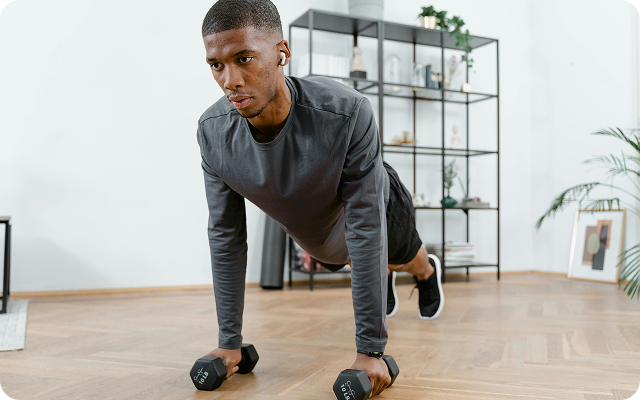Low-impact HIIT might not be the loudest or flashiest class on your timetable, but it’s one of the most strategic. If you’re looking to fill off-peak hours, attract new member segments, and increase overall class attendance, this format deserves a spot on your schedule.
It’s not just a workout trend. It’s an opportunity to make your gym more inclusive, profitable, and aligned with the needs of today’s diverse member base.
What Exactly Is a Low-Impact HIIT Workout?
Traditional HIIT relies on short bursts of intensity with brief rest periods, often involving high-impact exercises like burpees, jump lunges, and squat jumps.
Low-impact HIIT uses the same intensity and interval structure, without the joint stress.
Think:
- Fast-paced squats instead of jump squats
- Glute bridges instead of tuck jumps
- Modified push-ups instead of plyometrics
The goal is to keep the heart rate high while keeping the movements joint-friendly, making this format accessible to an incredibly broad audience.
The Business Case: Why Your Gym Needs This Class
1. Attract an Untapped Market
Your current programming may unintentionally exclude huge potential member groups:
- Beginners
- Active seniors
- Injury-prone clients
- Pre/post-natal members
- Clients intimidated by high-impact training
A low-impact HIIT class serves as the perfect, confidence-building entry point for them, creating a steady pipeline of new, loyal members.
2. Boost Retention With Smart Variety
Offering low-impact options keeps long-term members engaged and reduces the risk of burnout. It gives athletes a place for active recovery days while still offering a high-quality workout.
When members feel they always have a class that meets their needs, whether they’re sore, tired, or rehabbing, they stick around longer.
3. Increase Class Attendance
Accessibility = attendance. Low-impact HIIT is approachable, welcoming, and easy for new members to try. Regulars will use it often, too - especially on off days. This leads to:
- Fuller classes
- Better energy
- Stronger community connection
- Increased membership value
4. Minimal Investment, Maximum Return
Low-impact HIIT requires little to no equipment. Bodyweight, resistance bands, or light dumbbells are more than enough.
That means:
- Low start-up cost
- Easy rollout
- Immediate revenue potential
- More classes added without sacrificing floor space
How to Program a Great Low-Impact HIIT Class
Ready to give it a shot? Here’s a sample structure you or your trainers can use. The key is to focus on speed and control through the movements to get the heart rate up without the impact.
Here’s a simple but effective 30-minute structure your trainers can implement immediately. The focus is intensity through speed, control, and consistency, not impact.
Class Format: 30-minute workout, 2–3 rounds of the following circuit.
This format elevates heart rates, builds strength, and stays completely joint-friendly.
Getting the Word Out
Clear communication is key. When adding this class to your schedule in Recess, choose names like:
- Low-Impact HIIT
- Joint-Friendly HIIT
- HIIT for Every Body
From there, promoting it on social media and in newsletters becomes effortless, especially when your class schedule links directly to easy, one-click booking.
A Smarter, More Inclusive Way to Grow
A low-impact HIIT class isn’t a “softer” version of your programming, it’s a strategic expansion that:
Welcomes underserved populations
- Improves retention
- Reduces member intimidation
- Increases class participation
- Strengthens your community
Adding this format makes your gym more inclusive, more dynamic, and better equipped to meet members where they are.



